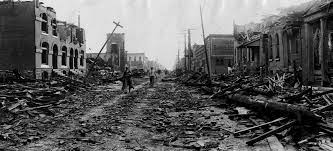On September 29, 1923, the United States experienced a series of devastating tornadoes that left a path of destruction across multiple states. These tornadoes, which struck with little warning, caused significant loss of life and property damage, highlighting the destructive power and unpredictability of these natural phenomena. The outbreak of tornadoes on September 29, 1923, occurred primarily in the Midwest region of the United States, with the states of Illinois, Indiana, and Michigan being the hardest hit. The tornadoes formed as a result of severe thunderstorms and atmospheric instability, which created the ideal conditions for their development. The tornadoes struck with ferocious intensity, tearing through communities and leaving a trail of destruction in their wake. Homes, businesses, and infrastructure were leveled, and entire neighborhoods were reduced to rubble. The force of the winds was so powerful that it uprooted trees, flipped cars, and caused widespread debris to be scattered for miles. The loss of life resulting from the September 29, 1923 tornado outbreak was significant. The exact number of fatalities is difficult to determine due to the limited record-keeping and communication systems of the time. However, estimates suggest that hundreds of people lost their lives, and thousands more were injured or displaced. The tornadoes on this day also had a profound impact on the affected communities. The destruction of homes and infrastructure left many people homeless and without basic necessities. The recovery and rebuilding efforts were arduous and required significant resources and support from neighboring communities and the government. In the aftermath of the tornado outbreak, communities rallied together to provide aid and support to those affected. Relief efforts were organized to provide emergency shelter, food, and medical assistance to survivors. The resilience and determination of the affected communities were evident as they worked tirelessly to rebuild their lives and restore their communities. The September 29, 1923 tornado outbreak served as a wake-up call to the nation about the destructive power of tornadoes and the need for improved warning systems and preparedness measures. In the aftermath of the disaster, there was a renewed focus on researching tornadoes and developing methods to detect and predict their formation. This led to advancements in meteorology and the establishment of tornado warning systems that have since saved countless lives. Today, the events of September 29, 1923, serve as a reminder of the devastating impact that tornadoes can have on communities. The lessons learned from this outbreak have informed subsequent efforts to better understand tornado formation and behavior, as well as to improve early warning systems and preparedness measures. While tornadoes remain a natural disaster that is difficult to predict and control completely, advancements in technology and communication have significantly improved our ability to forecast and warn of their occurrence. Efforts to educate the public on tornado safety and preparedness continue to be emphasized, with the aim of minimizing the loss of life and property damage caused by these destructive forces of nature. As we remember the events of September 29, 1923, we honor the resilience and strength of the affected communities and recommit ourselves to ongoing efforts to understand and mitigate the impact of tornadoes on society.
29 Sept, 1923 U.S.A. Tornadoes
